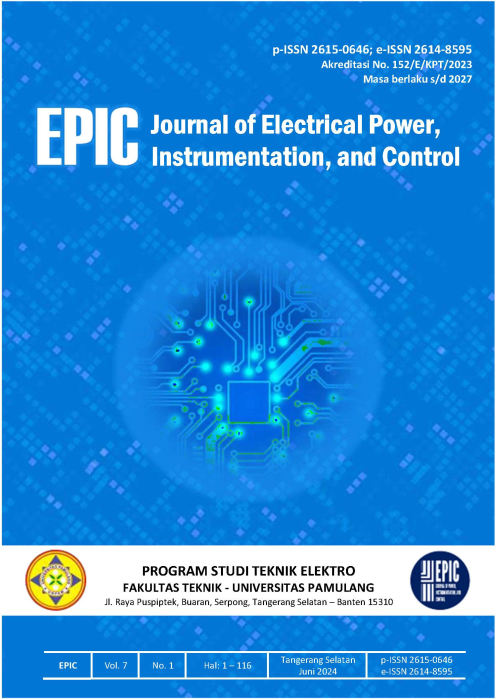Rancang Bangun Robot Selam Mini Berbasis Arduino
DOI:
https://doi.org/10.32493/epic.v7i1.39665Keywords:
Arduino nano, mini ROV, remote flysky-i6Abstract
The innovation of submerged or submerged robots is currently prominent enough to be noticed by the general public, the country and even the world. Previously there were still many submerged exercises that were controlled using cable media. In this research, the diving robot controller uses wireless conductive media. Because currently robots can move submerged, it is hoped that they can help human activities. The Submerged Pack robot is an Arduino-based ROV (Remotely Operated Vehicle) which is smaller than usual. This robot uses 4 engines to move and is equipped with a camera and lighting frame to screen submerged conditions. Arduino as the main microcontroller controls the Flysky FS-i6 via a link so that the robot can be controlled from above the water surface. The essence of this examination is to be able to design submerged robots that can replace traditional submerged exercises. The main thing in the scaled-down ROV plan is its control frame and watertight frame. The framework for the observation and lighting system uses lights and is equipped with a camera. The expected results from this diving robot are normal, that the robot can move according to the four commands which can be applied as a prototype for observing diving.
References
Adhipramana, M., Mardiati, R., & Mulyana, E. (2020). Remotely Operated Vehicle (ROV) Robot For Monitoring Quality of Water Based on IoT. 2020 6th International Conference on Wireless and Telematics (ICWT), 1–7. https://doi.org/10.1109/ICWT50448.2020.9243614
Diptya Widayaka, P., & Sujiwa, A. (2020). HOLD HEADING POSITION SYSTEM OF UNDERWATER REMOTELY OPERATED VEHICLE BASED ON PID. BEST : Journal of Applied Electrical, Science, & Technology, 2(2), 1–6. https://doi.org/10.36456/best.vol2.no2.3463
Irawan, F., & Yulianto, A. (2015). PERANCANGAN PROTOTYPE ROBOT OBSERVASI BAWAH AIR DAN KONTROL HOVERING MENGGUNAKAN METODE PID CONTROL. Jurnal Sains Dan Informatika, 1(1), 63–70.
Loua, L. R., Lestari, D., Yuniarti, E., & , R. (2023). Design and Control Underwater Robot Based on Smartphone. Al-Fiziya: Journal of Materials Science, Geophysics, Instrumentation and Theoretical Physics, 6(I), 30–39. https://doi.org/10.15408/fiziya.v6iI.32368
Mazaya, M. S. (2019). Design of remotely operated vehicle as installer tools of tidal turbine and seismograph under water. Indonesian Journal of Electrical Engineering and Computer Science, 15(1), 183. https://doi.org/10.11591/ijeecs.v15.i1.pp183-189
Santo Gitakarma, M., Udy Ariawan, K., & Arya Wigraha, N. (2014). Alat Bantu Survey Bawah Air Menggunakan Amoba, Robot Berbasis ROV. JST (Jurnal Sains Dan Teknologi), 3(2), 392–409. https://doi.org/10.23887/jst-undiksha.v3i2.4476
Septian, R. A., Rahmania, A., Nugraha, M. I., & Yudhi, Y. (2019). Remotely Operated Vehicle (ROV) Untuk Eksplorasi Bawah Air Di Lingkungan Industri Perkapalan. Manutech : Jurnal Teknologi Manufaktur, 9(02), 15–22. https://doi.org/10.33504/manutech.v9i02.41
Setiawan, A. E., Mardiati, R., & Mulyana, E. (2020). Design of Automatic Under Water Robot System Based on Mamdani Fuzzy Logic Controller. 2020 6th International Conference on Wireless and Telematics (ICWT), 1–5. https://doi.org/10.1109/ICWT50448.2020.9243615
Tamam, B. (2017). Development of Water-Surface Robotic Vehicle to Assist Communication Between Remotely Operated Vehicle Underwater Robot and Control Station. JAREE (Journal on Advanced Research in Electrical Engineering), 1(2). https://doi.org/10.12962/j25796216.v1.i2.28
Waldiansyah, R., Sutisna, S. P., & Ahmad, A. R. (2019). PENGUJIAN PERFORMA 2 DEGREE OF FREEDOM UNDERWATER REMOTELY OPERATED VEHICLE (ROV. AME (Aplikasi Mekanika Dan Energi): Jurnal Ilmiah Teknik Mesin, 5(2), 66. https://doi.org/10.32832/ame.v5i2.2430
Downloads
Published
How to Cite
Issue
Section
License
Copyright (c) 2024 EPIC Journal of Electrical Power Instrumentation and Control

This work is licensed under a Creative Commons Attribution-NonCommercial-ShareAlike 4.0 International License.
This journal provides immediate open access to its content on the principle that making research freely available to the public, supporting a greater global exchange of knowledge.

Journal of Electrical Power, Instrumentation and Control adhere to Attribution-ShareAlike 4.0 International license.
Journal of Electrical Power, Instrumentation and Control menganut lisensi Atribusi-BerbagiSerupa 4.0 Internasional.




















